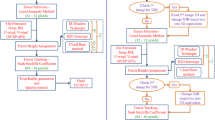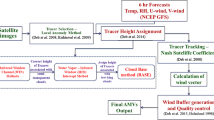Abstract
In this study, an attempt has been made to advance the error characteristic of atmospheric motion vectors (AMVs) derived from the infrared and water vapour channels of Kalpana-1 very high resolution radiometer by comparing against stereo motion vectors (SMVs) retrieved by tracking clouds from the multi-angle imaging spectro-radiometer (MISR) for a period of 9 months. Two different versions of the MISR SMVs with horizontal resolutions 70.4 and 17.6 km, respectively, are used for the inter-comparison. It is found that the Kalpana-1 AMV has stronger westerlies and southerlies than the MISR SMV at all latitudes and levels in majority of times. The performances of Kalpana-1 AMVs against MISR SMVs are assessed by doing a similar analysis where Meteosat-7 AMVs (infrared and water vapour AMVs) are also evaluated against the MISR SMVs for the same region. It is found that results of both AMVs (Kalpana-1 and Meteosat-7) with both sets of MISR SMVs are comparable with few exceptions. The zonal wind components of the MISR SMVs showed smaller mean wind difference and root mean square difference (RMSD) compared to the meridional wind components. The SMVs are typically assigned to higher altitudes than AMVs. Analysis related to the height discrepancies between MISR SMVs and AMVs shows that in the multi-layer cloud AMVs are tracked in upper level cloud targets, while SMVs are skewed more towards lower level. The accuracy is better for the low level where collocations are highly dense and gradually decreases towards the higher levels. Because of improvement in the MISR SMV retrieval algorithm, the errors in the meridional component of SMVs have improved in the recently released version with horizontal resolution of 17.6 km.













Similar content being viewed by others
References
Berger H, Langland R, Velden CS, Reynolds CA, Pauley PM (2011) Impact of Enhanced satellite derived atmospheric motion vector observations on numerical tropical cyclone track forecast in the Western North Pacific during TPARC/TCS-08. J Appl Meteorol Climatol 50:2309–2318
Deb SK, Kishtawal CM, Pal PK, Joshi PC (2008) A modified tracer selection and tracking procedure to derive winds using water vapour imagers. J Appl Meteorol Climatol 47:3252–3263
Deb SK, Kishtawal CM, Pal PK (2010) Impact of kalpana-1 derived water vapour winds on Indian ocean tropical cyclone forecast. Mon Weather Rev 138(3):987–1003
Deb SK, Kumar P, Pal PK, Joshi PC (2011) Assimilation of INSAT data in the simulation of the recent tropical Cyclone Aila. Int J Rem Sens 32(18):5135–5155
Deb SK, Kishtawal CM, Kaur I, Pal PK, Kiran Kumar AS (2013) Assessment of a new quality control technique in the retrieval of atmospheric motion vectors. Meteorol Appl. doi:10.1002/met.1433. (Online published: 14 October 2013)
Deb SK, Wanzong S, Velden CS, Kaur I, Kishtawal CM, Pal PK, Menzel WP (2014a) Height assignment improvement in kalpana-1 atmospheric motion vectors. J Ind Soc Remote Sens. doi:10.1007/s12524-013-0278-z. (Online published: 20 March 2014)
Deb SK, Kaur I, Kishtawal CM, Pal PK (2014b) Comparison of kalpana-1 atmospheric motion vector with other observations. Theor Appl Climatol 115:693–702
Diner DJ, Davies R, Girolamo LD, Horváth A, Moroney C, Muller JP, Paradise S, Wenkert D, Zong J (1999) MISR Level 2 cloud detection and classification algorithm theoretical basis, JPL Tech. Doc. D-11399, Rev. D, Jet Propulsion. Laboratory., California. Institute of Technology, Pasadena.
EUMETSAT (1996) Meteorological Products Extraction Facility (MPEF). Algorithms Specification Document, Darmstadt
Goerss JS, Velden CS, Hawkins JD (1998) The impact of multispectral GOES-8 wind information on Atlantic tropical cyclone forecasts in 1995 Part II: NOGAPS forecasts. Mon Weather Rev 126:1219–1227
Holmlund K, van de Berg L, Gustafsson J, de Smet A, Carranza M, Dew G, Borde R (2010) Current status of EUMETSAT operational winds, The Proceedings Tenth International Winds Workshop 20–24 February 2010. Tokyo, Japan
Horvath A (2013) Improvements to MISR stereo motion vectors. J Geophys Res. doi:10.1002/jgrd.50466
Horvath A, Davies R (2001) Feasibility and error analysis of cloud motion wind extraction from near-simultaneous multiangle MISR measurement. J Atmos Ocean Technol 18(4):591–608
Kishtawal CM, Deb SK, Pal PK, Joshi PC (2009) Estimation of atmospheric motion vectors from kalpana-1. J Appl Meteorol Climatol 48:2410–2421
LeMarshall JF, Pescod N, Khaw A, Allen G (1993) The real-time generation and application of cloud-drift winds in the Australian region. Aust Meteorol Mag 42:89–103
Leslie LM, LeMarshall JF, Morison RP, Spinoso C, Purser RJ, Pescod N, Seecamp R (1998) Improved hurricane track forecasting from the continuous assimilation of high-quality satellite wind data. Mon Weather Rev 126:1248–1257
Lonitz K, Horváth A (2011) Comparison of MISR and Meteosat-9 cloud-motion vectors. J Geophys Res 116:D24202. doi:10.1029/2011JD016047
Mueller K, Garay MJ, Girolamo LD, Jovanovic V, Moronet C (2010) MISR Cloud Motion Vector Product Algorithm Theoretical Basis, JPL Tech Doc. D-64973, Jet Propul. Lab., Calif. Inst. of Technol., Pasadena
Mueller K, Moroney C, Jovanovic V, Garay MJ, Muller JP, Girolamo LD, Davies R (2013) MISR Level 2 cloud product algorithm theoretical basis, JPL Tech. Doc. D-73327, Jet Propul. Lab., Calif. Inst. of Technol., Pasadena
Nash JE, Sutcliffe JV (1970) River flow forecasting through conceptual models part I: a discussion of principles. J Hydrol 10(3):282–290
Spinoso C (1997) The measurement of wind velocity from geostationary satellite observed radiances. PhD. Thesis, RMIT (Royal Melbourne Institute of Technology) University, 268 pp
Velden CS, Bedka KM (2009) Identifying the uncertainty in determining satellite-derived atmospheric motion vector height attribution. J Appl Meteorol Climatol 48:450–463
Velden CS, Holmlund K (1998) Report from the working group on verification and quality indices (WG III). Fourth International Winds Workshop, EUMETSAT, Saanenmoser
Velden CS, Hayden CM, Menzel WP, Franklin JL, Lynch JS (1992) The impact of satellite-derived winds on numerical hurricane track forecasting. Weather Forecast 7:107–118
Velden CS, Olander TL, Wanzong S (1998) The impact of multispectral GOES-8 wind information on Atlantic tropical cyclone track forecasts in, 1995. Part I: dataset methodology, description, and case analysis. Mon Weather Rev 126:1202–1218
Acknowledgments
The authors are thankful to the anonymous reviewers for the critical and insightful comments and suggestions which have significantly improved the quality and presentation of the current version of the manuscript. The MOSDAC portal (www.mosdac.gov.in) of Space Applications Centre (SAC), ISRO, Ahmedabad is acknowledged for making Kalpana-1 data available on operational basis. The Director SAC and the Deputy Director, EPSA SAC, ISRO Ahmedabad are acknowledged for their encouragement and help during the course of this study. The authors are also thankful to Kevin Mueller of JPL NASA for providing MISR SMVs data through International Winds Working Group (IWWG) for making this study possible. The European Organisation for the Exploitation of Meteorological Satellites (EUMETSAT) is acknowledged for providing Meteosat-7 AMV data through the EUMETSAT website.
Author information
Authors and Affiliations
Corresponding author
Rights and permissions
About this article
Cite this article
Deb, S.K., Kaur, I., Kishtawal, C.M. et al. A comparative assessment of Kalpana-1 and MISR cloud tracked winds over the Indian Ocean region. Theor Appl Climatol 121, 425–443 (2015). https://doi.org/10.1007/s00704-014-1246-4
Received:
Accepted:
Published:
Issue Date:
DOI: https://doi.org/10.1007/s00704-014-1246-4




